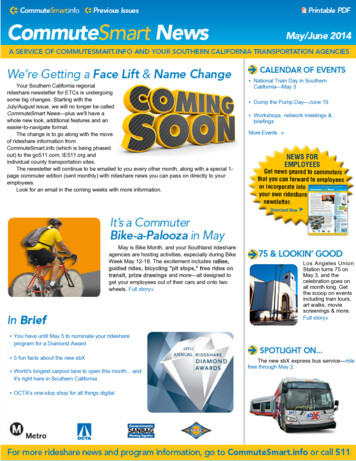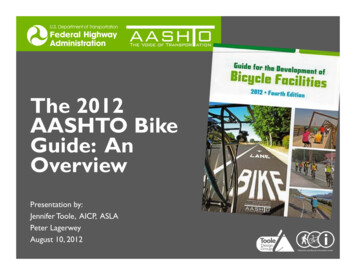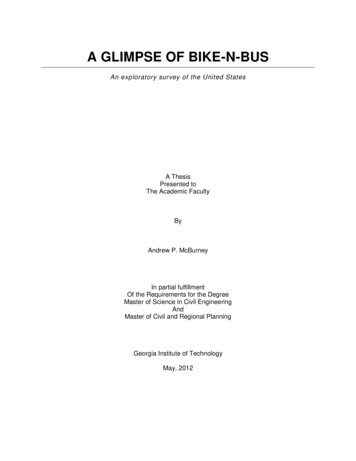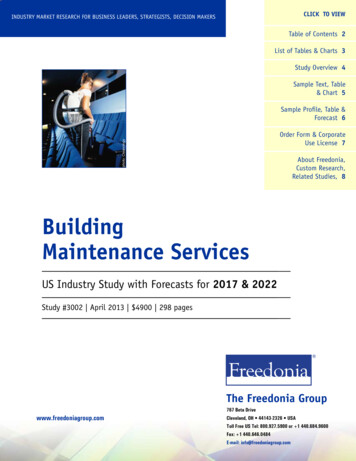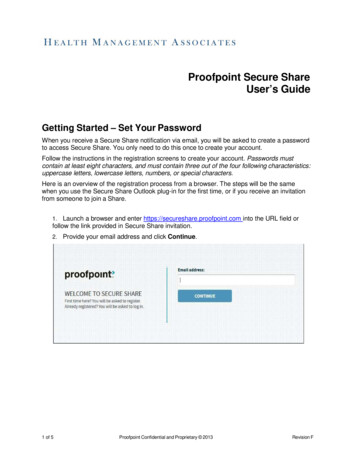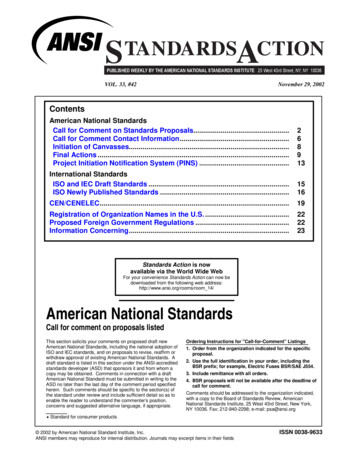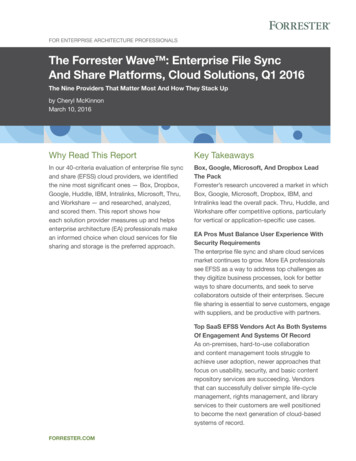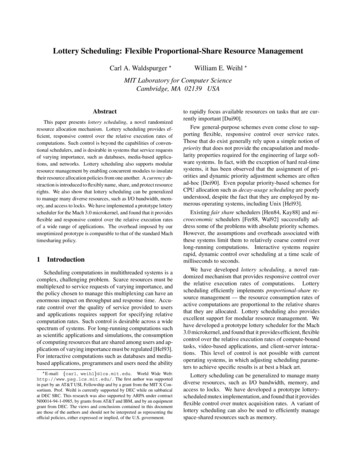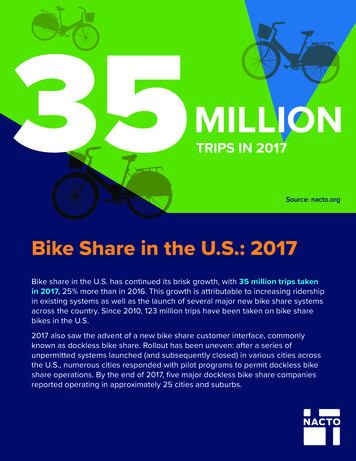
Transcription
TRIPS IN 2017Source: nacto.orgBike Share in the U.S.: 2017Bike share in the U.S. has continued its brisk growth, with 35 million trips takenin 2017, 25% more than in 2016. This growth is attributable to increasing ridershipin existing systems as well as the launch of several major new bike share systemsacross the country. Since 2010, 123 million trips have been taken on bike sharebikes in the U.S.2017 also saw the advent of a new bike share customer interface, commonlyknown as dockless bike share. Rollout has been uneven: after a series ofunpermitted systems launched (and subsequently closed) in various cities acrossthe U.S., numerous cities responded with pilot programs to permit dockless bikeshare operations. By the end of 2017, five major dockless bike share companiesreported operating in approximately 25 cities and suburbs.
BIKE SHARE SYSTEMS IN THE U.S.: 2017MAP LEGENDSTATION-BASEDDOCKLESSSTATION-BASED& DOCKLESSSource: nacto.orgMore Systems, More Cities,More Bikes, More CompaniesThe number of bike share companies operating in the U.S. also grewdramatically in 2017. From 2010 to 2016, most U.S. bike share equipment andservices were provided by three major companies, B-Cycle, Motivate, andSocial Bicycles, with a few cities using equipment and services from smallercompanies such as NextBike.As of the end of 2017, five new major dockless companies – Jump (formerlySocial Bicycles), Limebike, MoBike, Ofo, and Spin – and a number of smallercompanies – e.g., Pace (formerly Zagster), Donkey Republic, VBike, LennyBike,and Riide – opened systems in the U.S. A sixth new major company,BlueGoGo, which was the first to roll out dockless bike share bikes in the U.S.,declared bankruptcy over the summer.Bike Share in the U.S.: 2017, NACTO2
Dockless bike share bikes in Washington, D.C.In 2017, the number of bike share bikes in the U.S. more than doubled –from 42,500 bikes at the end of 2016 to about 100,000 bikes by the end of2017. The majority of the increase in bikes came from new dockless systems.During the second half of 2017, dockless bike share companies introducedaround 44,000 bikes in cities across the country. Station-based systemsadded approximately 14,000 bikes to their fleets, bringing the 2017 total to54,000 station-based bikes. As of the close of 2017, dockless bike share bikesaccounted for about 44% of all bike share bikes in the U.S.The large influx of dockless bike share bikes across the U.S. has not yettranslated into substantial mobility gains. NACTO estimates that up to 1.4million trips were made on dockless bike share bikes in the U.S. in 2017,making up about 4% of trips. NACTO’s methodology for counting docklessbike share trips is provided in the Appendix.Using the intensity metric of rides per bike per day (r/b/d), U.S. station-basedsystems produced an average of 1.7 r/b/d. In contrast, dockless bike sharesystems nationally had an average of about 0.3 r/b/d. Analysis by theUniversity of Washington, adjusting for a changing number of bikes over the 6month pilot period, shows a r/b/d of 0.8 in Seattle.11Interviews with Seattle Department of Transportation and University of Washington.Bike Share in the U.S.: 2017, NACTO3
PERCENT OF TOTAL BIKES AND TRIPSDOCKLESS V. STATION-BASEDDOCKLESSBIKES44% 56%4%STATION-BASEDBIKES96%DOCKLESS TRIPSSTATION-BASED TRIPSSource: nacto.orgEXCLUDING THE FOUR LARGESTSTATION-BASED SYSTEMS*:DOCKLESSBIKES58%16%DOCKLESS TRIPS42%STATION-BASEDBIKES84%STATION-BASED TRIPS* The four largest station-based systems are Citi Bike (NYC), Divvy (Chicago),Hubway (Greater Boston Area), & Capital BikeShare (Washington, DC).Bike Share in the U.S.: 2017, NACTOSource: nacto.org4
Growing Ridership2017 saw the launch of a number of new station-based systems; notably inHonolulu (Biki), Detroit (MoGo), New Orleans (Blue Bikes), and Charleston(HolySpokes). The San Francisco Bay Area system re-launched as Ford GoBikewith 7,000 bikes, a ten-fold increase from the area’s prior system. In addition,dockless companies piloted bikes in approximately 25 cities across the U.S.including Seattle, Washington DC, Dallas, Aurora CO, and Charlotte NC.Four large station-based systems – Citi Bike NYC, Divvy, Capital Bikeshare,and Hubway – generated the majority (74%) of all rides taken in the UnitedStates in 2017, similar to previous years. However, bike share growth iswidespread across many cities. In Philadelphia, for example, the Indego bikeshare system increased ridership by 84% over 2016.BIKE SHARE RIDERSHIP INTHE U.S. SINCE 2010Source: nacto.orgBike Share in the U.S.: 2017, NACTO5
Several recently-launched systems have attracted substantial numbers ofriders. Biki in Honolulu launched in July 2017, and quickly became the eighthmost heavily used bike share system in the U.S., with 365,000 rides taken todate. Detroit’s MoGo system saw 112,000 trips taken in six months, includingduring some of the lowest November and December temperatures on record.More systems have subsidizedlow-income passesThe national increase in ridership also comes from work in cities around thecountry to make bike share more affordable to a wide cross-section of people.Many of these efforts are documented by the Better Bike Share Partnership.For example, in Philadelphia, work to develop and promote a 5 AccessPass,available to Pennsylvanians receiving food assistance, has resulted in anincrease in low-income Philadelphians using the Indego Bike Share system.In 2017, AccessPass sales made up about 15% of all sign ups and AccessPassusers took 9% of all trips.Among cities with station-based bike share systems, 32% have an incomebased discount program, using income thresholds or living in affordablehousing as criteria. This is a 33% increase over 2016 when about a quarter ofall cities had income-based discount programs.Newer systems, such as Detroit’s MoGo, have followed this model. MoGolaunched with a widely-publicized 5 annual AccessPass, available toDetroiters who receive state food assistance. After six months, AccessPasssales have made up 18% of all long-term pass sales. MoGo also offersa cash-payment membership option which is well used by AccessPassholders. Together, AccessPass and the cash-option provide fast, flexible, andconvenient access to transportation for hundreds of residents.Bike Share in the U.S.: 2017, NACTO6
Further north, the Citi Bike program in New York City completed its 5th year ofproviding 5/month annual memberships for New York City Housing Authority(NYCHA) residents and select community-based credit union members. Inaddition, in tandem with a partnership effort managed by the communitydevelopment organization, Bed-Stuy Restoration, Citi Bike opened a newoperational facility, hiring NYCHA residents as mechanics and ‘CommunityChampions.’ The number of NYCHA residents using Citi Bike nearly doubled in2017 to 1,500 active members.22NYCHA and Citi Bike Announce Partnership to open Citi Bike Operations Facilities atRiis Houses. (2017, August 22). Retrieved from http://www1.nyc.gov.Bike Share in the U.S.: 2017, NACTO7
How is bike share used?Understanding who is riding and how bike share is used can be difficult. Moststation-based systems collect some demographic data on annual or monthlypass holders but very little on one-time users. Conducting bike share interceptsurveys is not yet widespread practice. Dockless bike share companies do notshare demographic data, making it hard to get beyond anecdote.In July 2017, the city of Seattle launched a pilot program to allow dockless bikeshare companies to operate in the city. At the end of 2017, this pilot programincluded four dockless bike share companies and approximately 9,000bikes. To accommodate the companies’ concerns about proprietary data andaddress Washington’s FOIA laws, independent researchers at the Universityof Washington were employed to gather and analyze the dockless bike sharedata. To date, the Seattle pilot provides some of the best available data onhow dockless bike share is used.Data from Seattle suggests that dockless bike share may be used differentlyfrom station-based bike share systems in other places around the U.S. andworld. For example, typically station-based systems generate the most tripson weekdays and use within the average day follows 9-5 commuting patterns.In 2017, 48% of all station-based bike share trips took place during rushhours (7-9AM or 4-6PM), and 76% of all trips took place on weekdays.3In contrast, dockless bike share in Seattle has an evening peak but no morningrush-hour peak and trips are spread out over the day with highest use seen onweekends, suggesting more recreational use.The presence of weekday and AM/PM rush hour peaks is important because itsuggests that station-based systems are part of a city’s overall transportationnetwork and are used in the course of a typical commute to work or school.For instance, annual member surveys from Washington, DC and Chicago alsoshow significant bike share to transit crossover: 65% of Capital Bike Sharemembers and 42% of Divvy members respectively report using bike share aspart of longer transit commutes.434Interviews with Seattle Department of Transportation and University of Washington.How Do People Use Bike Share? (2017, May 4). Retrieved from https://www.motivateco.comBike Share in the U.S.: 2017, NACTO8
TRIP PROFILES IN STATION-BASED SYSTEMSTRIPS BY HOUR OF THE DAY14%12%10%8%6%4%2%0%12123456789 10 1112123- AM -456789 10 11- PM -TRIPS BY DAY OF THE %TUESDAY10%MONDAY12%WEDNESDAY14%AVERAGE TRIP DURATIONLONG-TERM PASS HOLDERS12 MINUTESCASUAL USERS28 MINUTESSource: nacto.orgBike Share in the U.S.: 2017, NACTO9
Looking forwardChecking out a B-Cycle in Austin, TXWith 35 million trips in 2017 and strong year-on-year growth since 2010,bike share is gaining hold as a transportation option in cities across theU.S. Significant ridership in an ever-widening collection of cities and clearindications of cross-over use between bike share and traditional bus and railtransit indicate that bike share can provide an essential mobility option forpeople in U.S. cities.The landscape around dockless bike share is less clear. In less than a yearof existence, one U.S.-focused company, BlueGoGo, and a number of Chinabased companies have filed for bankruptcy, merged with other companies,or ceased operations.5 The extreme degree of venture capital funding,coupled with generally low ridership, brings questions as to the overallsustainability and volatility of the dockless bike share market. Cities areproceeding cautiously, watching the results of pilot efforts, and encouragingdockless companies to share more data so that cities can better evaluate andunderstand how dockless bike share can further city goals of safety, equity,and sustainable mobility.5Tchebotarev, E. (2017, December 16). With Hundreds of Millions of Dollars Burned,The Dockless Bike Sharing Market Is Imploding. Retrieved from https://www.forbes.comBike Share in the U.S.: 2017, NACTO10
Appendix: what do we know and how dowe know it?Station-Based Trip DataAs in Bike Share in the U.S.: 2010 - 2016, NACTO collected trip data fromall publicly available station-based systems with more than 100 bikes or tenstations.Dockless Trip DataMost dockless bike share companies claim their trip data as proprietary. Howand what data is shared with cities varies by city and company. There are nocomprehensive mechanisms in place to ensure data quality or comparabilityacross markets. As a result, it is difficult to know how many trips have beenmade or who is riding dockless systems. To date, the Seattle pilot, where tripdata is compiled and analyzed by independent/third party data analysts atthe University of Washington, provides some of the best information aboutwhether dockless bike share is helping to improve mobility and who isbenefiting.NACTO’s estimate of up to 1.4 million dockless trips reflects much of theuncertainty about this data. Most of the dockless companies publicly provideinformation about total mileage traveled but not total trips. Thus, NACTO’stotal dockless trip estimate combines two sources:1.2.Total number of trips recorded by company (if available)Total miles traveled by company divided by average trip lengthIn developing the estimate, NACTO also assumed two possible average triplengths to create a “high” and “low” estimate for the total number of docklessbike share trips. The “high” estimate (1.4 million trips) assumes a 1.5 mileaverage trip length, the average dockless trip length in Seattle as reported bythe University of Washington. The “low” estimate (1.1 million trips) assumes athree mile average, on par with how casual or one-time users tend to use bikeshare in station-based systems.Bike Share in the U.S.: 2017, NACTO11
National Association of City Transportation OfficialsReport design by: HakiCreatives.com
The San Francisco Bay Area system re-launched as Ford GoBike with 7,000 bikes, a ten-fold increase from the area’s prior system. . (NYCHA) residents and select community-based credit union members. In addition, in tandem with a partnership effort managed by the community . Checking out a B-Cycle in Austin, TX

